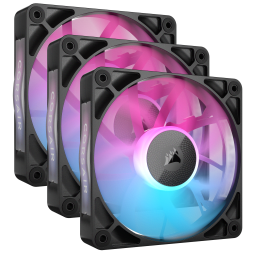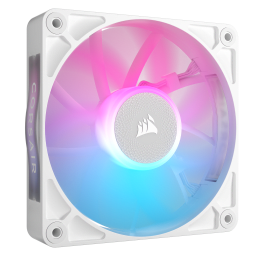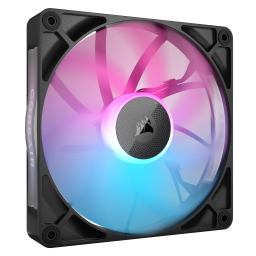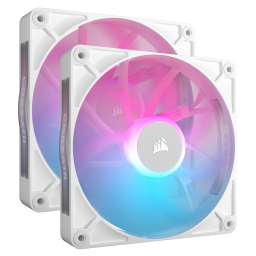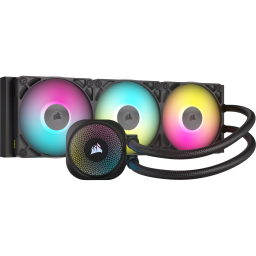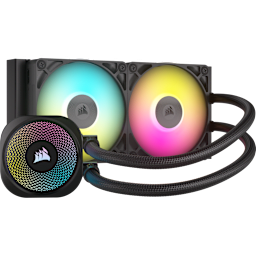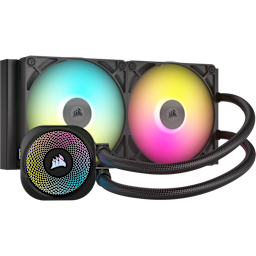Răspuns foarte scurt: Da. Răspuns puțin mai lung: Da, puteți, deși există câteva lucruri pe care trebuie să le aveți în vedere atunci când faceți acest lucru, deoarece ventilatoarele livrate cu cooler-ul All-in-One (AIO) au fost selectate în funcție de performanța generală. Acestea fiind spuse, există o mulțime de motive pentru care ați putea dori să vă schimbați ventilatoarele - de la dorința de a adăuga un pic de RGB bling la sistemul dvs. la necesitatea de a înlocui ventilatoarele rupte sau defecte. Iată la ce trebuie să vă gândiți când vă schimbați ventilatoarele AIO.

Dimensiunea ventilatorului contează
Poate părea evident, dar merită precizat de la bun început, pentru a nu vă trece prin cap nicio idee prostească atunci când cumpărați ventilatoare de înlocuire - trebuie să căutați ventilatoare de aceeași dimensiune ca cele pe care le aveți în prezent. Deși este adevărat că ventilatoarele de 140 mm pot funcționa mai lent decât unitățile de 120 mm pentru a deplasa aceeași cantitate de aer, acest lucru nu este de mare folos dacă nu le puteți atașa cu ușurință la radiatoare în primul rând.
Desigur, unii tinichigii întreprinzători vor vedea acest lucru ca pe o provocare și vor încerca să conecteze niște ventilatoare supradimensionate pentru a-și demonstra punctul de vedere, iar acest lucru este evident în regulă. Dar pentru toți ceilalți, dacă AIO-ul dvs. actual are ventilatoare de 120 mm, atunci ventilatoarele de 120 mm sunt calea de urmat. Verificați ce aveți înainte de a cumpăra orice înlocuitor, dar marea majoritate a răcitoarelor AIO disponibile astăzi utilizează unul, două sau trei ventilatoare de 120 mm pentru a răci radiatoare AIO de 120 mm, 240 mm sau 360 mm. Alternativ, s-ar putea să aveți unul, două sau chiar trei ventilatoare de 140 mm care fac aceeași treabă, de data aceasta atașate la radiatoare de 140 mm, 280 mm sau 420 mm.

Presiune statică
Dimensiunea este importantă, dar acesta nu este sfârșitul căutării specificațiilor dacă doriți să utilizați un ventilator cu radiatoarele dvs. Evaluarea importantă aici este ceva numit presiune statică, iar aceasta definește cât de bine ventilatoarele pot împinge aerul printr-un obstacol, cum ar fi radiatorul AIO. Merită evidențiat aici faptul că există două tipuri principale de ventilatoare atunci când doriți să mențineți un PC rece, cele care acordă prioritate presiunii statice ridicate și cele care se concentrează mai mult pe fluxul de aer. Merită să vă puneți materia cenușie în jurul acestui subiect, motiv pentru care avem un articol care acoperă într-un mod foarte clar diferența dintre ventilatoarele cu presiune statică și cele cu flux de aer ridicat. Concluzia este că doriți ventilatoare cu presiune statică ridicată pentru radiatoarele dvs. AIO.
Acest lucru va duce probabil la întrebarea: câtă presiune statică căutați, iar aici merită să căutați fișa de specificații pentru ventilatoarele dvs. actuale. În esență, ventilatoarele care se livrează cu AIO-ul dvs. au fost concepute pentru a menține funcționarea optimă a întregului dispozitiv pe o gamă de procesoare. Dacă înlocuiți aceste ventilatoare cu unele care nu se potrivesc cu cele originale, acestea vor trebui să lucreze mai mult, adică să funcționeze mai repede și mai tare, pentru a obține același nivel de răcire.
Presiunea statică se măsoară în mm-H2O și, pentru majoritatea ventilatoarelor, specificațiile pentru ventilatoarele dvs. prezintă presiunea statică ca interval, deoarece cantitatea de aer pe care o poate deplasa un ventilator va crește pe măsură ce viteza ventilatorului crește. Prin urmare, atunci când căutați acele înlocuitori, căutați ventilatoare care spun că sunt concepute pentru a fi utilizate cu radiatoare și care ating numere de presiune statică care sunt în general similare cu cele pe care le aveți în prezent.

Cu titlu de exemplu, să spunem că aveți cooler-ul iCUE H100i RGB ELITE AIO și doriți să actualizați ventilatoarele negre cu unele care au un strop magic de LED-uri RGB. Ventilatoarele care se livrează cu H100i sunt AF ELITE și au o presiune statică de 0,09-1,92 mm-H2O - puteți verifica acest lucru singur pe specificațiile tehnice pentru H100i. Dacă vă uitați la un kit de ventilatoare cum ar fi iCUE LINK RX120 RGB 120mm, atunci veți vedea că aceste ventilatoare oferă o presiune statică de 0,12-4,33 mm-H2O, ceea ce este mai mult decât suficient pentru activitatea în cauză. Evident, aceste ventilatoare au nevoie și de un Hub iCUE LINK, dar ați prins ideea.
Dacă doriți să actualizați RGB-ul mașinii dvs., este o idee bună să vă uitați la înlocuirile AIO întregi, deoarece acestea pot fi mai ieftine decât ați crede. AIO-urile mai noi sunt mai eficiente și multe dintre ele sunt deja echipate cu RGB. Există o mulțime de AIO-uri pe magazinul web CORSAIR principal.
PRODUSE ÎN ARTICOL
